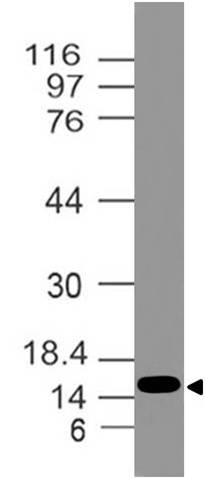Recombinant Mouse Interleukin-33/IL-33
Shipping Info:
For estimated delivery dates, please contact us at [email protected]
| Amount : | 50 µg |
| Content : | Lyophilized from a 0.2 µm filtered solution of 20mM PB,150mM NaCl,pH7.4. |
| Storage condition : | Lyophilized protein should be stored at -20°C, though stable at room temperature for 3 weeks. Reconstituted protein solution can be stored at 4-7°C for 2-7 days. Aliquots of reconstituted samples are stable at -20°C for 3 months. |
| AA sequence : | MSIQGTSLLTQSPASLSTYNDQSVSFVLENGCYVINVDDSGKDQEQDQVLLRYYESPCPASQSGDGVDGKKLMVNMSPIKDTDIWLHANDKDYSVELQRGDVSPPEQAFFVLHKKSSDFVSFECKNLPGTYIGVKDNQLALVEEKDESCNNIMFKLSKI |
Source: E. coli.
MW :17.6kD.
Recombinant Mouse Interleukin-33 is produced by our E.coli expression system and the target gene encoding Ser109-Ile266 is expressed. Mouse Interleukin 33 (IL-33) is a proinflammatory cytokine which may also regulates gene transcription in producer cells. IL-33 is structurally related to IL-1, which induces helper T cells to produce type 2 cytokines and acts through the receptor IL1RL-1. BindingIL-33 to this receptor activates NF-kappa-B and MAP kinases and induces in vitro Th2 cells to produce cytokines. In vivo, IL-33 induces the expression of IL-4, IL-5, IL-13 and also leads to severe pathological changes in mucosal organs.
MW :17.6kD.
Recombinant Mouse Interleukin-33 is produced by our E.coli expression system and the target gene encoding Ser109-Ile266 is expressed. Mouse Interleukin 33 (IL-33) is a proinflammatory cytokine which may also regulates gene transcription in producer cells. IL-33 is structurally related to IL-1, which induces helper T cells to produce type 2 cytokines and acts through the receptor IL1RL-1. BindingIL-33 to this receptor activates NF-kappa-B and MAP kinases and induces in vitro Th2 cells to produce cytokines. In vivo, IL-33 induces the expression of IL-4, IL-5, IL-13 and also leads to severe pathological changes in mucosal organs.
Endotoxin : Less than 0.1 ng/µg (1 IEU/µg) as determined by LAL test.
For Research Use Only. Not for use in diagnostic/therapeutics procedures.
| Subcellular location: | Nucleus, Chromosome, Cytoplasmic vesicle, Secreted |
| Post transnational modification: | The full-length protein can be released from cells and is able to signal via the IL1RL1/ST2 receptor. However, proteolytic processing by CSTG/cathepsin G and ELANE/neutrophil elastase produces C-terminal peptides that are more active than the unprocessed full-length protein. May also be proteolytically processed by calpains. Proteolytic cleavage mediated by apoptotic caspases including CASP3 and CASP7 results in IL33 inactivation. In vitro proteolytic cleavage by CASP1 was reported (PubMed:16286016) but could not be confirmed in vivo (PubMed:19465481) suggesting that IL33 is probably not a direct substrate for that caspase. |
| BioGrid: | 218533. 1 interactions. |
|
There are currently no product reviews
|
















.png)










